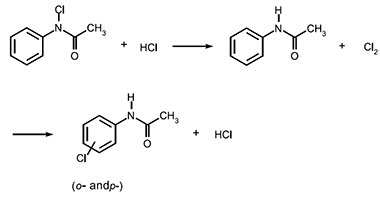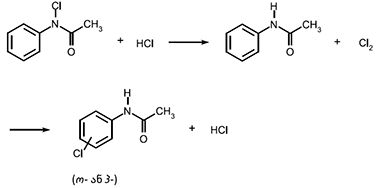ქიმიის ტერმინთა განმარტებითი ლექსიკონი
- ინგლისურ-ქართული
- ქართულ-ინგლისური
- ლექსიკონის შესახებ
- გამოხმაურება

| molecular rearrangement | მოლეკულური გადაჯგუფება |
| The term is traditionally applied to any reaction that involves a change of connectivity (sometimes including hydrogen), and violates the so-called “principle of minimum structural change”. According to this oversimplified principle, chemical species do not isomerize in the course of a transformation, e.g. substitution, or the change of a functional group of a chemical species into a different functional group is not expected to involve the making or breaking of more than the minimum number of bonds required to effect that transformation. For example, any new substituents are expected to enter the precise positions previously occupied by displaced groups. The simplest type of rearrangement is an intramolecular reaction in which the product is isomeric with the reactant (one type of “intramolecular isomerization”). An example is the first step of the Claisen rearrangement:
The definition of molecular rearrangement includes changes in which there is a migration of an atom or bond (unexpected on the basis of the principle of minimum structural change), as in the reaction:
where the rearrangement stage can formally be represented as the “1,2-shift” of hydride between adjacent carbon atoms in the carbocation:
Such migrations occur also in radicals, e.g.:
The definition also includes reactions in which an entering group takes up a different position from the leaving group, with accompanying bond migration. An example of the latter type is the “allylic rearrangement”:
A distinction is made between “intramolecular rearrangements” (or “true molecular rearrangements”) and “ intermolecular rearrangements” (or “apparent rearrangements”). In the former case the atoms and groups that are common to a reactant and a product never separate into independent fragments during the rearrangement stage (i.e. the change is intramolecular), whereas in an “intermolecular rearrangement” a migrating group is completely free from the parent molecule and is re-attached to a different position in a subsequent step, as in the Orton reaction:
|
ტერმინი ტრადიციულად გამოიყენება ნებისმიერ რეაქციაზე, რომელიც მოიცავს ბმის ცვლილებას (ზოგჯერ წყალბადის ჩათვლით) და ე. წ. „მინიმალური სტრუქტურული ცვლილების პრინციპს“ არღვევს. ამ ზედმეტად გამარტივებული პრინციპის მიხედვით, გარდაქმნისას ქიმიური ნაწილაკები არ იზომერიზდებიან, ანუ ქიმიური ნაერთის ფუნქციური ჯგუფის ჩანაცვლება ან სხვა ჯგუფად მისი გარდაქმნა არ საჭიროებს მოსალოდნელ მინიმალურ რაოდენობაზე მეტი ქიმიური ბმის წარმოქმნას ან გაწყვეტას. მაგალითად, მოსალოდნელია, რომ ნებისმიერი ახალი ჩამნაცვლებელი ზუსტად იმ პოზიციას დაიკავებს, რომლებიც ადრე ჩანაცვლებულ ჯგუფებს ეკავა. გადაჯგუფების უმარტივესი ტიპია მოლეკულათაშორისი რეაქცია, რომელშიც პროდუქტი რეაგენტის იზომერია („მოლეკულათაშორისი იზომერიზაციის“ ერთ-ერთი ტიპი). ამის მაგალითია კლაიზენის გადაჯგუფების პირველი საფეხური:
მოლეკულური გადაჯგუფების განმარტება მოიცავს ისეთ ცვლილებებსაც, რომელთა დროსაც ატომი ან ბმა გადანაცვლდება (რაც არაა გათვალისწინებული მინიმალური სტრუქტურული ცვლილების პრინციპის მიხედვით). მაგალითად, ეს ხდება რეაქციაში:
სადაც გადაჯგუფების ეტაპი შეიძლება ფორმალურად იყოს წარმოდგენილი, როგორც კარბოკატიონში მომიჯნავე ნახშირბადატომებს შორის ჰიდრიდის „1,2 წანაცვლება“:
ასეთი მიგრაცია ასევე ხდება რადიკალებშიც, მაგალითად:
განმარტება მოიცავს რეაქციებსაც, რომლებშიც შემომავალი ჯგუფი გამავალისაგან განსხვავებულ პოზიციას იკავებს, რასაც ბმების გადანაცვლება ახლავს თან. ამ უკანასკნელის მაგალითია "ალილური გადაჯგუფება":
განასხვავებენ „შიგამოლეკულურ გადაჯგუფებას“ (ან "ჭეშმარიტ მოლეკულურ გადაჯგუფებას") და „მოლეკულათაშორის გადაჯგუფებას“ (ან „მოჩვენებით გადაჯგუფებას“). პირველ შემთხვევაში, ატომები და ჯგუფები, რომლებიც საერთოა რეაგენტსა და პროდუქტში, გადაჯგუფების ეტაპზე დამოუკიდებელ ფრაგმენტებად არასოდეს იყოფა (ე.ი. ცვლილება შიგამოლეკულურია), მაშინ როცა „მოლეკულათაშორისი გადაჯგუფებისას“ გადანაცვლებული ჯგუფი მთლიანად თავისუფლდება საწყისი მოლეკულისაგან და მომდევნო ეტაპზე ხელახლა უერთდება მას, ოღონდ სხვა პოზიციაზე, როგორც ეს ორტონის რეაქციაში ხდება:
|
| Source | წყარო: PAC, 1994, 66, 1077 (Glossary of terms used in physical organic chemistry (IUPAC Recommendations 1994)) on page 1142 |
|















